Related Research Articles
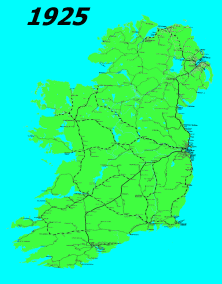
The history of rail transport in Ireland began only a decade later than that of Great Britain. By its peak in 1920, Ireland had 3,500 route miles (5,630 km). The current status is less than half that amount, with a large unserviced area around the border area between Northern Ireland and The Republic of Ireland.

Pearse railway station or Dublin Pearse is a railway station on Westland Row on the Southside of Dublin, Ireland. It is Ireland's busiest commuter station and second busiest station overall with 9 million passenger journeys through the station in 2016.

The Dublin and South Eastern Railway (DSER), often referred to as the Slow and Easy, was an Irish gauge railway in Ireland from 1846 to 1925. It carried 4,626,226 passengers in 1911. It was the fourth largest railway operation in Ireland operating a main line from Dublin to Wexford, with branch lines to Shillelagh and Waterford. The company previously traded under the names Waterford, Wexford, Wicklow & Dublin Railway to 1848, Dublin and Wicklow Raillway (D&WR) to 1860 and Dublin, Wicklow and Wexford Railway (DW&WR) until 1906.

Dún Laoghaire (Mallin) railway station is a station in Dún Laoghaire, Dún Laoghaire–Rathdown, Ireland.
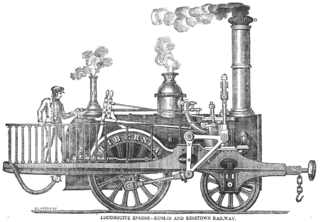
The Dublin and Kingstown Railway (D&KR), which opened in 1834, was Ireland's first passenger railway. It linked Westland Row in Dublin with Kingstown Harbour in County Dublin.
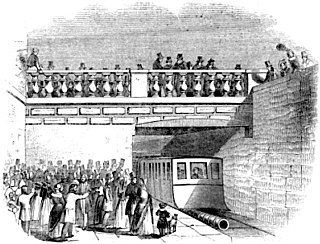
The Dalkey Atmospheric Railway was an extension of the Dublin and Kingstown Railway (D&KR) to Atmospheric Road in Dalkey, County Dublin, Ireland. It used part of the Dalkey Quarry industrial tramway, which was earlier used for the construction of Kingstown Harbour. It was the first commercial railway of its type in the world.

Hotel Riu Plaza The Gresham Dublin, formerly The Gresham Hotel, is a historic four-star hotel on O'Connell Street in Dublin, Ireland. It is a Dublin institution and landmark building which was refurbished in the early 2000s.
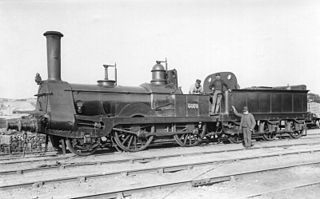
Alexander Allan was a Scottish mechanical engineer. He was born at Montrose, Angus, in 1809 and died at Scarborough, Yorkshire on 2 June 1891.

Hibernia was a steam locomotive designed by Richard Roberts and built by Sharp, Roberts and Company in 1834 for the Dublin and Kingstown Railway (D&KR). The locomotive had vertical cylinders driving via bell cranks.

The Waterford, Limerick and Western Railway (WL&WR), formerly the Waterford and Limerick Railway up to 1896, was at the time it was amalgamated with the Great Southern and Western Railway in 1901 the fourth largest railway in Ireland, with a main line stretching from Limerick to Waterford and branches to Sligo and Tralee.
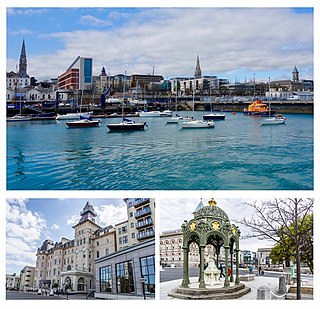
Dún Laoghaire is a suburban coastal town in County Dublin in Ireland. It is the administrative centre of the county of Dún Laoghaire–Rathdown. The town was built up alongside a small existing settlement following 1816 legislation that allowed the building of a major port to serve Dublin. It was known as Dunleary until it was renamed Kingstown in honour of King George IV's 1821 visit, and in 1920 was given its present name, the original Irish form from which "Dunleary" was anglicised. Over time, the town became a residential location, a seaside resort, the terminus of Ireland's first railway and the administrative centre of the former borough of Dún Laoghaire, and from 1994, of the county of Dún Laoghaire–Rathdown.

Pim Brothers & Co. was part of the interests of the Pim Brothers, business entrepreneurs based in Dublin in the first half of the nineteenth century.
Grand Canal Street railway works, also known as The Factory, served the Dublin and Kingstown Railway (D&KR), its successors the Dublin, Wicklow and Wexford Railway (DW&WR) and the Dublin and South Eastern Railway (DSER). It was preceded by a small "engine hospital" maintenance depot at Serpentine Avenue.
The Dublin, Wicklow and Wexford Railway (DW&WR) Ariel Class refers to seven 2-2-2WT well tank locomotives built by Neilson and Company and introduced in 1865.

Swiftsure was first of eight or more similar locomotives with a single pair of driving wheels built by George Forrester and Company (Forresters) from 1834. The tank variant was the first passenger tank engine to enter service in the world.
Princess was the class lead for a set of five locomotives built by the Dublin and Kingstown Railway (D&KR) in their own Grand Canal Street works from 1841. Princess was both the first locomotive built in Ireland and the first locomotive to be completed by a railway company in the British Isles in their own workshops.
Star was a locomotive designed by Isaac Dodds of the 2-2-0 configuration and built in 1833 at the Horsley Coal & Iron Company, Tipton, Birmingham, England. Despite rebuilds it was never a successful engine and was scrapped in 1840.
Burgoyne was the class lead for a set of four locomotives built by the Dublin and Kingstown Railway (D&KR) in their own Grand Canal Street works from 1845.

John Melling (1782-1856) was the locomotive superintendent for the Liverpool and Manchester Railway (L&MR) and contributed several railway engineering patents. Melling was a key person in the operation of the L&MR through the early pioneering days of the L&MR.
Thomas Fleming Bergin was an Irish civil engineer and early Irish railway official. He was the Company Clerk of the Dublin and Kingstown Railway (D&KR), the first public railway in Ireland. He was also responsible for the design of the Bergin Patent Spring Buffer, the buffering system that it used.
References
- 1 2 3 4 "Jonathan Pim – 2 July 1832–". FamilySearch. Archived from the original on 12 September 2019. Retrieved 13 September 2019.
- 1 2 Harrison (1987), vii.
- 1 2 3 Murray (1981), p. 22.
- ↑ Mountmellick Development Association (2009), The Pim Family.
- ↑ Harrison (1987), pp. vii, 266, 318.
- ↑ Swindley (2010), 11 November 1823.
- ↑ Harrison (1987), p. 266–267.
- 1 2 Harrison (1987), p. 271.
- ↑ Shepherd (1974), p. 13.
- ↑ Committee (1827), pp. 12–13.
- ↑ Murray (1981), p. 21.
- ↑ Murray (1981), pp. 14–15, 21.
- ↑ Murray (1981), pp. 16, 21.
- 1 2 3 Grierson (1887), p. 76.
- ↑ Murray (1981), p. 28.
- ↑ Murray (1981), p. 34.
- ↑ Murray (1981), p. 40.
- ↑ Murray (1981), pp. 46–53.
- ↑ Murray (1981), pp. 55, 57–59.
- ↑ Murray (1981), pp. 54–55.
- ↑ Murray (1981), pp. 63–74.
- ↑ Murray (1981), p. 96.
- ↑ Harrison (1987), pp. 356–372.
- ↑ Murray (1981), pp. 186–187.
- ↑ Grierson (1887), p. 66.
- ↑ "We celebrate a long history and some remarkable people: The Baileys and The Pims". Bailey and Pim. Archived from the original on 4 November 2017.
{{cite web}}: CS1 maint: unfit URL (link) - ↑ Hateley-Browne, Andrew (11 July 2016). "Wellesley, Alice and the Pim Sisters". The Leprosy Mission Australia. Archived from the original on 25 March 2019.
- ↑ Shepherd (2009), pp. 37–38.